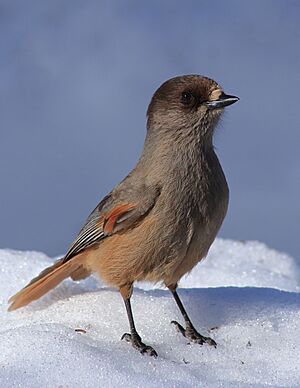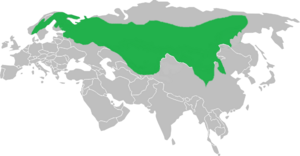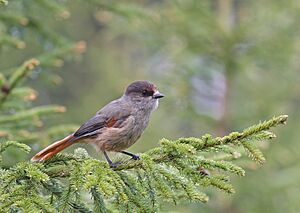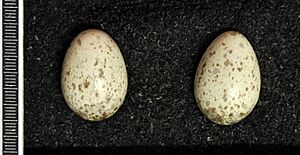Siberian jay facts for kids
Quick facts for kids Siberian jay |
|
|---|---|
 |
|
| Near Kittilä, Finland | |
| Conservation status | |
| Scientific classification | |
 |
|
| Current approximate range according to the IUCN |
The Siberian jay (Perisoreus infaustus) is a small bird that lives in the pine and spruce forests of Northern Europe and Asia. It has brownish-grey feathers, a darker brown head, and a lighter throat. You can spot rusty-red patches near its wings, under its tail, and on the sides of its tail. Both male and female Siberian jays look alike. Even though their forest homes are shrinking, these birds are quite common and live across a very wide area. Because of this, the International Union for Conservation of Nature says they are a "least concern" species, meaning they are not currently in danger.
Contents
About the Siberian Jay
The Siberian jay was first officially described by a Swedish scientist named Carl Linnaeus in 1758. He gave it the scientific name Corvus infaustus. The word infaustus comes from Latin and means "unlucky" or "unfortunate." This is because people used to think Siberian jays brought bad luck. Today, the Siberian jay is grouped with the Canada jay and the Sichuan jay in a genus called Perisoreus.
There are five main types, or subspecies, of Siberian jay:
- P. i. infaustus: Found from Scandinavia to western Siberia.
- P. i. rogosowi: Lives in northeastern European Russia to north-central Siberia.
- P. i. opicus: Found in eastern Kazakhstan, northwestern China, and south-central Siberia.
- P. i. sibericus: Lives in central Siberia and northern Mongolia.
- P. i. maritimus: Found in southeastern Siberia and northeastern China.
Siberian jays are different from other jays in their group living habits. Unlike some other jays where unrelated birds help raise the young, Siberian jays in a group do not help the parents with their chicks. This might be because, in the past, it was safer for them not to draw attention to their nests by having too many birds around.
After the last ice age, when the climate warmed, Siberian jays likely spread from east to west. They moved into the new pine and spruce forests that grew in Scandinavia.
Appearance and Sounds
The Siberian jay is the smallest of the crow family birds in western Europe and Asia. It weighs about 75 to 90 grams and is about 30 centimeters long. Adult birds have soft, downy, greyish-brown plumage (feathers). Their head is dark brown, their forehead is lighter, and their chest is a buff color. Their lower back is yellowish, and their chin and throat are grey. They also have reddish streaks on their outer tail feathers. Their beak and legs are black.
Their colors help them blend in with the forest, hiding them from predators. Their soft, fluffy feathers also keep them warm in the very cold winters. They shed their old feathers and grow new ones once a year, from mid-June to mid-September. The longest a Siberian jay has been known to live is 13 years and 4 months, but they usually live for about 7.1 years.
Siberian jays are good at flying through thick forests. However, they are not very good at flying across open areas. This might be why they are more easily caught by birds of prey when they are outside the forest.
Voice
Siberian jays are usually quiet. But they can make a loud screech that sounds like a buzzard (a type of hawk). Both male and female jays sing, mostly during the breeding season. Their song is a mix of soft and harsh notes, whistles, creaks, and trills. They can even copy the songs of other birds.
Siberian jays also make alarm calls to warn their family members about a predator. These warning calls help other jays react faster and survive. Female jays seem to be better than males at telling the difference between their own family and other jays. A female jay's alarm call might also help distract a predator away from her chicks.
Where They Live and Their Home
The Siberian jay lives all year round in the northern spruce, pine, cedar, and larch forests. These forests stretch from Scandinavia across northern Russia and Siberia. This bird lives in a huge area, about 19.3 million square kilometers. They are native to Norway, Sweden, Finland, Russia, Mongolia, Kazakhstan, and China. Sometimes, they might wander into Belarus, Estonia, Latvia, Poland, Slovakia, and Ukraine. They usually stay in one place, but some birds in the eastern parts of their range might move south in winter.
These jays prefer dense, old forests with lots of trees that form a thick roof (closed canopy). Spruce forests are their favorite places to find food and build nests. This is because spruce trees have thicker leaves than other trees, which helps hide the birds from predators. Nests in dense foliage are better hidden, meaning eggs and chicks are safer from predators. Siberian jays are very picky about where they live. Their ideal home includes old, dense spruce swamps with lots of plants. Their territories also have different types of areas, like old bushes, groves of trees, and wet meadows. So, if you see Siberian jays living in an area, it usually means the forest is very healthy and diverse.
Behavior and Life Cycle
Siberian jays have a unique and complex way of living together. They live in small groups of 2 to 7 birds. A main breeding pair is at the center of the group. The group also includes their young from different years and sometimes unrelated birds that have joined them.
Within a group, there is a pecking order, or dominance hierarchy. Males are usually dominant over females. Breeding birds are dominant over non-breeding birds. Some non-breeding males can even be dominant over breeding females. Groups can be made up of only family members, families with unrelated birds, or even just unrelated birds. Unrelated birds can stay in the territory, but usually outside the main nesting areas.
Siberian jays can be aggressive towards unrelated birds that enter their territory. They might approach and force an intruder away, or even chase them in flight. Chasing takes more energy. Breeding birds are much more aggressive towards unrelated birds than towards their own young. Females tend to get more aggression than males. This is because males are higher in the social order and resist more, which costs the aggressor more energy. Siberian jays seem to learn to recognize their own young rather than knowing them by genetics. Experiments showed they treated their own chicks the same as chicks they fostered.
Reproduction
Siberian jays are strictly monogamous, meaning a pair stays together for life and keeps the same territory. Both males and females watch their partners closely to prevent them from mating with other birds. This helps ensure that both parents' genes are passed on. Their territory is about 1 to 4 square kilometers, and it gets a little bigger in autumn and winter. Even though they stick to their territory, jays might move if they find a better place to breed. If one partner dies, the widowed bird will find a new mate.
The nest is built in a pine or spruce tree, about 4 to 6 meters above the ground. It's hidden deep within the thick branches to protect it from predators. The nest is a loose cup made of dry twigs that the jays break off trees. It's lined thickly with beard lichen moss, soft feathers, spiderwebs, reindeer fur, and pieces of wasp nests. This thick lining is very important for keeping the eggs and chicks warm in the extremely cold winter. They collect nest material in winter, long before they start building. Actual nest building begins in late March and takes about three weeks. Both parents collect materials, but only the female builds the nest.
The eggs are pale green, blue, or grey, with grey and brown spots. They are about 31.6 x 22.9 mm in size. Eggs are laid between March 31 and April 22. A clutch (group of eggs) can have 1 to 5 eggs. The eggs hatch after about 19 days. Only the female sits on the eggs to keep them warm. The male brings all the food for the female and the chicks. Siberian jays only have one brood (set of chicks) per year. If their nest fails, they will not try again until the next year. They also build a new nest for every breeding attempt.
Newly hatched chicks are almost bare and are kept warm by the female. Young jays look similar to adults but have lighter-colored heads. A lot of the young birds' diet is insect larvae. The male collects these and stores them in his throat until he returns to the nest to feed them to the young. For the first week, the male provides all the food for the female and the chicks. After that, the female starts to help more with feeding.
The young birds fledge (grow feathers and learn to fly) in mid-May to early June. They leave the nest about 18 to 24 days after the first chick hatches. They usually hide in tree branches nearby until they can fly well. Parents continue to feed the young for about three weeks after they fledge. The whole family stays together through summer, autumn, and winter.
Most young jays leave their birth territory in their first summer, about 4 to 8 weeks after fledging. They join new groups, usually far from where they were born. These early leavers are usually the less dominant ones, pushed out by one or a few stronger siblings who stay behind. If young jays haven't left by eight weeks old, they usually stay in their birth territory at least through their first winter. The dominant young birds who stay might wait up to five years before leaving, waiting for a good chance to breed. Sometimes, they can even take over their birth territory if both parents disappear. Young jays might also inherit a new territory where they go to breed. If there are no empty territories, young jays can join another family group to get food. They might even try to start their own territory when they are 2 or 3 years old.
Parents often show favoritism (nepotism) towards their own young, especially those who stay in the birth territory. They give these young birds good access to food and protection from predators, which helps them survive. This also helps the parents pass on their genes. While staying longer might mean the young birds breed later, they often have more success breeding later in life because of the advantages they got from their parents. Studies have shown that jays who leave later tend to have more successful offspring over their lifetime than those who leave early.
At least one young bird usually stays with the parents after a successful breeding season. They often stay with the pair for at least a year, and some might stay for up to five years. These are the dominant young birds who out-compete their weaker siblings. The weaker siblings leave in their first summer and join other existing groups as non-breeding birds. They tend to travel much farther than their dominant siblings, who often move straight into a breeding spot in a new territory.
Unlike many other social birds in the crow family, Siberian jays in a group do not help the parents raise younger siblings in future years. So, young birds staying with their parents is not about helping to raise more chicks. Groups also stay together outside the breeding season, which is also unusual.
Feeding Habits
The Siberian jay eats many different things. It mainly feeds on berries, seeds, insects, and spiders. Groups of jays will also eat from large animal carcasses killed by predators like wolves and wolverines. Sometimes, they eat eggs of small birds, tit chicks, snails, slugs, small mammals, and lizards.
In autumn and winter, they collect berries (especially bilberries and cowberries) and hide them. They store food behind loose tree bark, in hanging beard lichen, and between forked twigs. Siberian jays hide many different food stashes over a large area. This is why they are called "scatter hoarders." However, unlike some other crow family birds, they don't share this hidden food with their siblings. They eat it themselves or another bird might steal it. These hidden food stashes are very important for the jays to survive winter, as there are only a few hours of daylight to find food.
To store food securely, Siberian jays have special saliva glands. They use their saliva to make sticky clumps of food. They can stick these clumps to beard moss or into holes in tree bark, where they can easily get to them all winter. Because they rely on stored food in winter, these birds are territorial. They keep their food reserves scattered around their territory, especially near their nest.
When looking for food, Siberian jays often stay inside the thick forest to avoid being seen by predators. However, they might sometimes look for insects in wet, open areas. They forage in groups of 3 to 5 birds within their large territory. Especially in winter, Siberian jays will go into more open areas to catch and store small rodents for food when there are many of them.
Threats to Siberian Jays
Birds of prey, like the goshawk and sparrowhawk, are the main predators of Siberian jays. Most of these predators find their prey by sight. So, the thick forest cover, combined with the jays' camouflaged colors and hidden nests, helps them stay safe. Predators that eat Siberian jay eggs and young include squirrels, ravens, hooded crows, magpies, and Eurasian jays. The jays build their nests in dense branches to avoid attracting predators. Females also seem to lay fewer eggs when there is a higher risk of predators. This might help avoid drawing attention to the nest, as fewer trips to the nest by the parents are needed. Also, in nests that are better hidden, chicks are fed more evenly, leading to better growth.
The Siberian jay population in Europe is threatened because their habitat is being damaged. This happens due to logging, building roads, new settlements, and farming. Modern forestry practices in Europe are making breeding habitats worse for the Siberian jay. This is because they remove too many trees, which means less cover for the birds. When too many trees are cut down (clearcutting), Siberian jays often leave their territories. This leads to a big drop in their breeding success in those areas. Another problem is replacing native spruce trees with pine trees. This can remove the visual cover that jays need to hide their nests from predators. In Finland, spruce forests are disappearing faster than other forest types. This loss and breaking up of spruce forests has led to fewer Siberian jays there.
Human activities might also be making natural threats worse. The Siberian jay population has declined more than can be explained by just cutting down forests. This might be because their nests are more exposed to bird predators, and other human activities might be helping these predators. For example, humans feeding birds or leaving out trash can help predators like Eurasian jays, which then increases the danger for Siberian jays. Also, cutting down trees where jays store food in winter can destroy their vital food caches.
Besides increased attention from predators, the open areas created by forest fragmentation also make it hard for jays to move around. They are not good at flying across open land. Siberian jays also seem unable to adapt quickly enough to these changes in habitat and predator numbers caused by humans. Because these birds tend to stay in one place, there are several groups that are genetically isolated. Even before modern forestry created strong barriers, there might have been little mixing between these groups because jays are very loyal to their home areas.
Siberian Jays and People
Siberian jays are known to be fearless around humans. If people regularly leave food for them in the same spot, they can become tame enough to take food from a hand. This used to happen a lot when forest workers left food scraps around their campfires for the jays.
Today, the Siberian jay is considered a "flagship species" for conservation. This means it's a symbol for protecting forests. This is because of the threats from modern forestry and because areas where Siberian jays live are seen as signs of high-quality, diverse forests.
Conservation Status
The IUCN has listed the Siberian jay as a "Least Concern" species. This is because the species lives across an extremely large area. Even though the global population is decreasing, the drop is not big enough to make the species Vulnerable (at high risk of extinction). The world population is very large, estimated to be between 4 and 8 million adult birds. The biggest population declines have been reported in the southernmost parts of their range.
Images for kids






